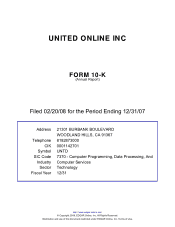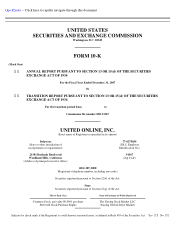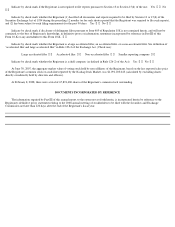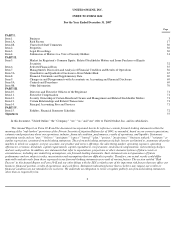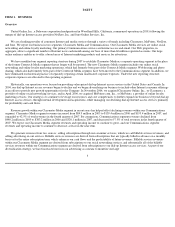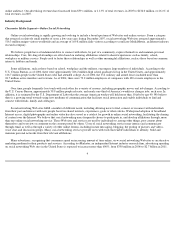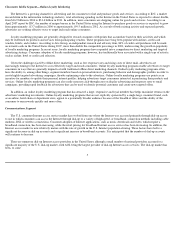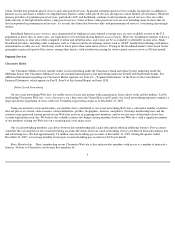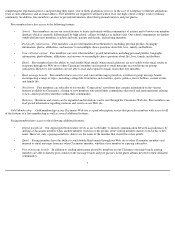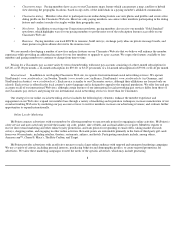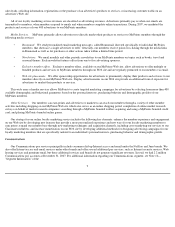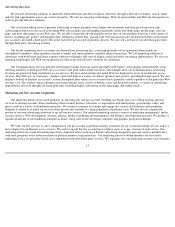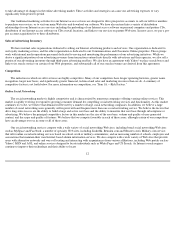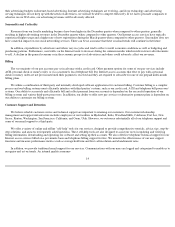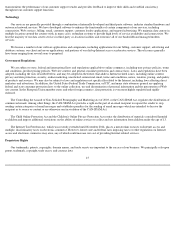Classmates.com 2007 Annual Report Download - page 7
Download and view the complete annual report
Please find page 7 of the 2007 Classmates.com annual report below. You can navigate through the pages in the report by either clicking on the pages listed below, or by using the keyword search tool below to find specific information within the annual report.
Classmates Media Segment
—
Online Loyalty Marketing
The Internet is a growing channel for advertising and for consumers to find and purchase goods and services. According to IDC, a market
research firm in the information technology industry, total advertising spending on the Internet in the United States is expected to almost double,
from $16.9 billion in 2006 to $31.4 billion in 2011. In addition, more consumers are shopping online for goods and services. According to an
April 2007 report by IDC, the number of unique buyers in the United States using the Internet to purchase goods or services is expected to grow
from approximately 113.7 million in 2006 to approximately 199.5 million in 2012. As a result of both existing activity and expected growth,
advertisers are seeking effective ways to target and reach online consumers.
Loyalty marketing programs are generally designed to reward consumers with points that accumulate based on their activities and which
may be redeemed for products and services from participating vendors. These programs have long been popular with airlines, credit card
vendors, hotels, and retailers. According to Aite Group, an independent research and advisory firm, 84% of credit card purchases will be made
on rewards cards in the United States during 2007, more than double the comparable percentage in 2001, underscoring the growth in popularity
of loyalty marketing programs. In recent years, loyalty marketing programs have expanded into a comprehensive direct marketing and targeted
advertising strategy. Consumer adoption of loyalty marketing programs, however, has traditionally been associated with a single type of activity,
such as airline, hotel or credit card selection.
Given the challenges faced by offline direct marketing, such as low response rates and rising costs of direct mail, advertisers are
increasingly turning to the Internet to cost-
effectively target and reach consumers. Online loyalty marketing programs enable advertisers to target
consumers in ways that are generally impractical with traditional offline direct marketing channels. Online loyalty marketing programs often
have the ability to, among other things, segment members based on personal interests, purchasing behavior and demographic profiles in order to
create highly targeted advertising campaigns, thereby optimizing value to the advertiser. Online loyalty marketing programs use points as an
incentive for members to update their personal interest profiles, helping advertisers target consumers interested in purchasing their products and
services. Online loyalty marketing programs can also easily measure click-through rates on display advertising and response rates to email
campaigns, providing rapid feedback for advertisers that can be used to identify potential customers and create new targeted offers.
In addition, an online loyalty marketing program that has attracted a large, responsive and loyal member base helps maximize returns on the
advertisers' marketing investments. Online loyalty marketing programs that are not explicitly sponsored by a single large consumer brand, such
as an airline, hotel chain or department store, appeal to a potentially broader audience because of the breadth of offers and the ability of the
consumer to earn rewards quickly and more often.
Communications Segment
The U.S. consumer Internet access service market has evolved from one where the Internet was accessed primarily through dial-up access
to one in which consumers can access the Internet through dial-up or a variety of high-speed, or broadband, connection methods including cable
modems, DSL or wireless connections. Consumer adoption of Internet applications, such as music downloads and video, which require a
broadband connection, has been increasing, while the retail pricing for broadband Internet access services has been decreasing. In addition, the
Internet access market is now relatively mature with the rate of growth in the U.S. Internet population slowing. These factors have led to a
significant decrease in dial-up accounts and a significant increase in broadband accounts. It is anticipated that the number of dial-up accounts
will continue to decrease.
There are numerous dial-up Internet access providers in the United States although a small number of national providers account for a
significant majority of the U.S. dial-up market, with AOL being the largest provider of dial-up Internet access services. The dial-up market has
been, to some
5

